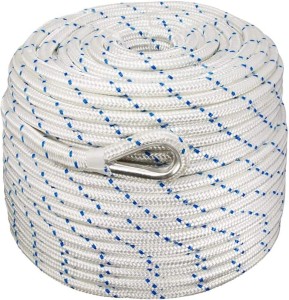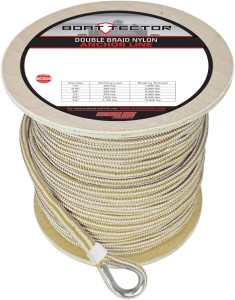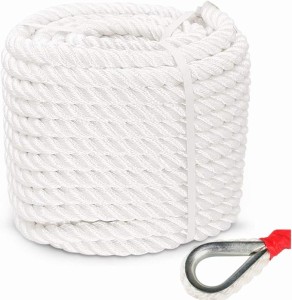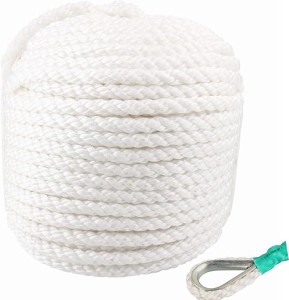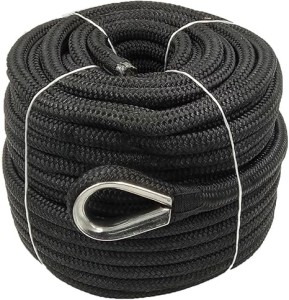What is the best type of anchor line?
The best types of anchor line to buy include both three-strand and double braided nylon ropes. Again, nylon is most certainly the way to go, due not only to the factors mentioned above, but also due to the lower cost.It’s also the most common type of anchor rope found in marine and sporting good stores, so it will be easy to find. Add the fact that it’s light and flexible and that it easily sinks, and you’ll see why double braided nylon anchor rope is the choice of most leisure and small boat owners.
What size anchor rope do I need?
This can sometimes be difficult to ascertain, but what we can give you is a good industry rule of thumb to go by.Basically, you’re going to want about one-eighth inch of braided anchor rope diameter for every nine feet of boat length. Put in simple terms, if you have a 30 foot boat, you’re going to want to buy a half-inch anchor rope.
As for how long you need the hollow braid anchor rope to be, you’ll want to have a good idea of what the anchoring depth is where you’re going to be boating. So refer to maps of the region, talk to the harbormaster or seasoned boaters and be prepared before heading out onto the open water.Once you’ve determined the approximate depth of the water, multiply that figure by eight and that’s how long the length of your anchor line should be. So if you’re going to be in 50 feet of water, you should have 400 feet of braided anchor rope.
Top Anchor Rope For Boats 2025
Product Image | Product Name | Our Rating | Price |
|---|---|---|---|
 | Norestar Anchor Rope |  |  |
 | Extreme Max BoatTector Anchor Line |  |  |
 | Twisted Anchor Rope |  |  |
Unless you’re operating a large ship and in need of heavy duty chains to secure your anchor, it’s a safe bet you’re going to be using a rode, also known as an anchor cable, to connect the anchor to your boat.The typical anchor rode used by pleasure boat captains is a long length of nylon line that is then connected to a short length of chain at the anchor end of the rode.
The chain is there essentially for extra strength and security, adding weight to the anchor line and helping it dig into the bottom of the lake or ocean floor.There are many important elements involved with being a safe and well prepared recreational boater, and guaranteeing that your anchor rode is made of the best materials is certainly one of them.If not secured properly, you could lose your anchor and your fun day out on the water will almost certainly come to an abrupt end. To help, you might even consider using a professionally spliced stainless steel thimble to easily attach the rope to your anchor.
To properly secure your boat anchor, you’re going to want to buy the best rope for your particular situation. There are a few choices on the market today, but some are certainly better than others.
Double braid nylon is the rope of choice not only because of its strength, but also because of its elasticity. When the boat is rocking back and forth or up and down due to the movement of the water, the nylon stretches like a rubber band and prevents any damage that could otherwise occur.
1
BEST DOUBLE BRAID ANCHOR ROPE
Norestar Anchor Rope
Added sturdy anchor line makes a great anchor rode for almost any type of boat
2
BEST NYLON ANCHOR LINE WITH THIMBLE
Extreme Max BoatTector Anchor Line
Extreme Max BoatTector items are developed to give optimal security for watercrafts as well as boat.This costs anchor line is ready to make use of, with a stainless-steel thimble on one end.
3
BEST TWISTED DOCKLINE BRAIDED ANCHOR ROPE
Twisted Anchor Rope
Dual Braided Nylon Anchor Rope offers exceptional toughness and is optimal for any kind of anchor rode arrangement, mooring setup, or nearly any other application.
4
BEST THREE STRAND BRAIDED BOAT DOCKLINE MOORING LINES
CarBole Twisted Anchor Rope
CarBole turned Polypropylene support rope is strong and also resilient with damaging strain 5,850 POUND.Perfect for rise lines, boat falls, decrease hammer ropes.
5
BEST DOUBLE NYLON BRAID ANCHOR ROPE
Marsstoreonline Nylon Rope Anchor Line
Premium double braided nylon support lines have excellent adaptability as well as stretch to absorb shock with a soft feel.Constructed from double knotted nylon, offering premium stamina and ease of handling.
Why do I need chain at the end of my anchor rope?
We already mentioned that it’s important to include some chain at the end of your anchor rode because of its weight, which will allow the anchor to remain in place for extended periods of time.But there are other reasons to include a little bit of chain at the end of your anchor node.
For one thing, chain resists abrasion from coral, sharp rocks and shellfish beds, while rope can suffer abrasion in the same set of circumstances. You don’t want the rope element to come in contact with the sea bed, but rather the line should be suspended in the water above the anchor.
What other types of anchor rope are there?
While nylon anchor rope is undoubtedly the most popular and best choice for most boaters, there are other rope-based options on the market.
The second choice is rope made of polyester, which is stronger than double braid nylon but not nearly as elastic.
Both nylon and polyester ropes sink, which means they’ll stay in place and not disturb other nearby boats, and neither absorbs much water. So a polyester anchor line does provide a decent second option, though the elasticity of nylon clearly makes it the top choice when deciding on an anchor rode for your watercraft.
In addition to these two top choices, other alternatives include polypropylene and natural fibers such as manila and hemp. The former, however, breaks down in sunlight and becomes difficult to handle, which the latter is primarily used in Third World countries where other line options are not readily available.
How do you attach the rope to boat anchors?
The most important quality you’ll need for properly attaching a rope to your boat anchor is patience. You’re going to want to be 100 percent certain that you’ve tied the perfect knot in your rope, so you’ll know without a shadow of a doubt that the anchor line will keep your boat securely connected to the sea floor.
The perfect rope knot is called an anchor bend, and this is something you’re going to want to master long before you’re actually out on the open sea. Again, consider buying and using a steel thimble to make things easier.
First, thread your rope though the last link of the boat anchor chain, leaving you about a foot of rope to work with. Then take that foot of rope and loop the end back through the chain link one more time, giving you two loops of rope now threaded through the final link of the chain.
Take the slack end of the rope and pull it through both loops, making sure they’re loose enough for the rope to easily slide through. You can now pull the rope tight, thus completing your anchor bend.
Test the anchor line to make sure it’s tight and secure and the breaking strength is adequate, but if done correctly this knot should be strong and easily hold your best anchor chain as you drop, and then later retrieve, your anchor.
What’s the best way to store my anchor rope?
Some boat captains just recoil their best anchor rope and leave it sitting on the deck of the boat. We don’t recommend this, however, as it can not only lead to safety issues but it also leaves your rope at the mercy of the elements around the clock.
Your rope could also end up sitting in water, leading to possible mold and mildew issues down the line.
To prevent this, there are storage options available for both recreational and commercial boat captains, including storage lockers, bins and even storage bags that are specifically designed for anchor ropes.
Do a little online research and choose the line option that’s best for you.
Be diligent with safety and maintenance
As with most items you’ll accumulate in your lifetime, properly caring for and maintaining these boating objects will determine how long they’ll adequately serve you.
Personal watercraft provide an amazing opportunity for being out on the open water and enjoying great times with your friends and family members. But just remember that proper boat maintenance and safety practices are extremely important during any time of year.
Ropes can fray and chains can rust, so be sure to keep a close eye on these items and perform regularly scheduled maintenance checks. It’s also important to have extra rope and chain physically on the boat, just in case they’re needed while you’re out at sea.
When in doubt, adopt the Boy Scouts motto of “Be Prepared!” It’s much better to have these items and not need them than to need them and not have them.
So the next time you go out and buy nylon rope, metal chain or even an anchor itself, buy a little extra and keep these items safe and secure on your watercraft.
And most importantly, have a great time out on the water.


